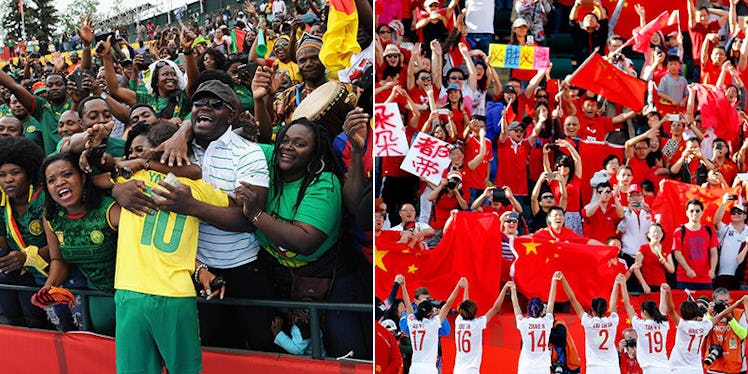When it was announced in 2013 that the 2015 Women’s World Cup would be played on artificial turf fields, we knew FIFA was yet again going to squander an opportunity to improve gender equality in sports.
Sure, a number of women spoke out against playing on turf, and 84 players from 13 different countries went so far as to bring a lawsuit against FIFA and the Canadian Soccer Association on the basis of gender discrimination, but that did little to force FIFA to go back on its decision.
Like raindrops trying to bring down a mountain.
And the fact that soccer’s global governing body refused to even entertain companies who offered to install natural grass fields for free, well, that pretty much says all you need to know about the organization’s chauvinistic, stubborn mentality.
This should come as no surprise, though, seeing as how in their 111-year history, FIFA has never allowed a female to be part of their executive committee.
You know, the same committee that in recent weeks has seen several members charged with bribery, corruption and being all-around terrible individuals.
But one of the most horrible things FIFA has done at Canada 2015 is the implementation of “gender verification” testing.
Another reason not to support FIFA. Gender verification of every member of every Women's team is a FIFA... http://t.co/2pvXad984d — Stoo Metz (@StooMetz) June 9, 2015
Before you open up another tab to see if that’s something that occurs in the men’s game, let me save you the time. It doesn’t.
FIFA announced their new gender verification regulations in 2011, claiming that both male and female players could be tested before any major tournament.
Like, anyone could be asked to show the contents of their bag on the subway, but more often than not it’s going to be the sketchy-looking guy or girl who’s forced to miss the train.
Mark Leather, the head of performance for English Championship side Bolton Wanderers, said,
I’ve never come across testing being carried out for men. The football authorities don’t make the men do any.
Surprise, surprise.
Again, we shouldn’t expect better from an organization that is led – for now, at least – by a president who suggested that the best way for the women’s game to gain in popularity was by having players wear tighter shorts.
But we do expect better.
It’s 2015, and Sepp Blatter’s sentiments are shared by at least one other high-ranking soccer official in Brazil, so it’s no wonder why women face an uphill climb in so many avenues of life.
As ESPNW points out, FIFA’s gender testing has two very disturbing principles:
- FIFA is taking it upon themselves to decide what it means to be a normal man or woman.
- If a female player is deemed to have higher levels of natural testosterone than an average woman, then that puts the rest of the field at a disadvantage.
This policy is so ass-backward it’s surprising the women of the 2015 World Cup aren’t being forced to play in bikinis with their country’s badge and a brand sponsor on each butt cheek.
But, despite playing this tournament with on and off the field disadvantages, the 2015 Women’s World Cup is a huge success.
According to reports, total attendance in Canada is expected to be at least 1.25 million.
Attendance record set in Edmonton for FIFA Women’s World Cup opening match http://t.co/aoI4RLCpI0 pic.twitter.com/lUevMEKuc3 — Global Calgary (@GlobalCalgary) June 7, 2015
While this number is short of the initial stated goal of 1.5 million, it will still break the current tournament record of 1,194,221 attendees, set at the 1999 World Cup in the United States.
The Canadian women’s team has already set (53,058) and broken (53,855) their national team home attendance record these past few weeks, and yes, that does include the men’s team.
#FOOTBALL #WWC2015 Media coverage in Canada is building. 'Canada to set attendance record. http://t.co/2nXT2UEFew … pic.twitter.com/V3TPZgVXdO — S♀ORT AUSTRALIA (@Twing_AUS) June 2, 2015
Numbers don’t lie.
Even though female soccer players are still facing adversity in almost every facet of the game – it’s beyond me why officiating crews can’t be a mix of male and female – they're combating it in the best way possible: by producing a superior on-field product.
It’s great to cheer on your nation’s women’s team at a local bar or at a friend’s place, but the fact that more fans than ever are getting in cars, busses, trains and planes to come watch the best female soccer players in the world speaks volumes.
Recently, an article was published to explain why FIFA reported the attendance of several matches at this Women’s World Cup as sold out, despite the fact that the stands often appeared no more than half-full.
Basically, you were able to watch a double-header in a buy-one-get-one deal, but fans often chose to attend only the game they intended to see when they purchased tickets in the first place.
Is it sexist that group stage match tickets were sold in pairs? Yes. Would that ever happen at the men’s World Cup? No.
But that doesn’t matter. Growing the women’s game is a process, and with that process comes growing pains.
One sellout match is better than none, isn’t it?
A look at the numbers proves the 2015 Women’s World Cup is narrowing the discrimination divide in sports.
Regardless of playing surface and outside distraction, these futbolistas are performing, and the world is watching.
